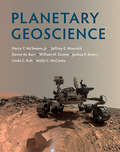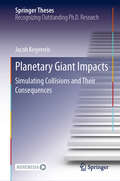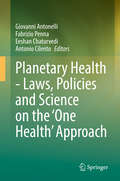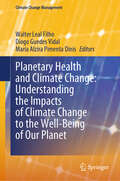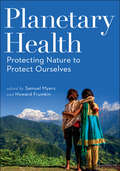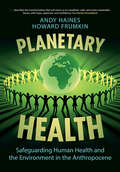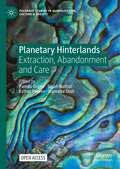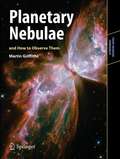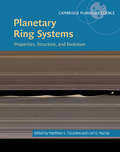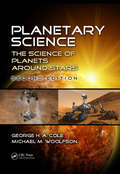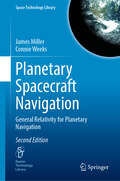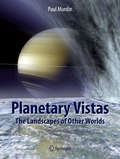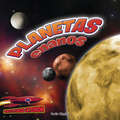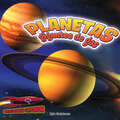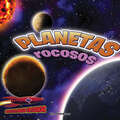- Table View
- List View
Planetary Geoscience
by Devon M. Burr Harry Y. McSween, Jr Jeffrey E. Moersch William M. Dunne Joshua P. Emery Linda C. Kah Molly C. McCantaFor many years, planetary science has been taught as part of the astronomy curriculum, from a very physics-based perspective, and from the framework of a tour of the Solar System - body by body. Over the past decades, however, spacecraft exploration and related laboratory research on extraterrestrial materials have given us a new understanding of planets and how they are shaped by geological processes. Based on a course taught at the University of Tennessee, Knoxville, this is the first textbook to focus on geologic processes, adopting a comparative approach that demonstrates the similarities and differences between planets, and the reasons for these. Profusely illustrated, and with a wealth of pedagogical features, this book provides an ideal capstone course for geoscience majors - bringing together aspects of mineralogy, petrology, geochemistry, volcanology, sedimentology, geomorphology, tectonics, geophysics and remote sensing.
Planetary Giant Impacts: Simulating Collisions and Their Consequences (Springer Theses)
by Jacob KegerreisBased on 3D smoothed particle hydrodynamics simulations performed with unprecedented high resolution, this book examines the giant impacts that dominate many planets’ late accretion and evolution. The numerical methods developed are now publicly available, greatly facilitating future studies of planetary impacts in our solar system and exoplanetary systems. The book focuses on four main topics: (1) The development of new methods to construct initial conditions as well as a hydrodynamical simulation code to evolve them, using 1000 times more simulation particles than the previous standard. (2) The numerical convergence of giant impact simulations -- standard-resolution simulations fail to converge on even bulk properties like the post-impact rotation period. (3) The collision thought to have knocked over the planet Uranus causing it to spin on its side. (4) The erosion of atmospheres by giant impacts onto terrestrial planets, and the first full 3D simulations of collisions in this regime.
Planetary Health - Laws, Policies and Science on the 'One Health' Approach
by Giovanni Antonelli Fabrizio Penna Eeshan Chaturvedi Antonio CilentoThis book offers a multidisciplinary and in-depth analysis of the One Health approach. The holistic One Health vision, a healthcare model based on the integration of various disciplines, is both ancient and current. It is based on the recognition that human health, animal health and ecosystem health are inextricably linked. Cognizant of the need for multidisciplinary research to address complex health challenges at the national and international level, the book combines legal, public policy and medical perspectives on the One Health approach, exploring e.g. the role of biodiversity, human rights, trade agreements, indigenous knowledge, and climate change mitigation and adaptation. One Health is officially recognized by the European Commission and by a host of international organizations as a relevant strategy for actors in all sectors that benefit from collaboration between disciplines (doctors, veterinarians, lawyers, environmentalists, economists, sociologists etc.). One Health is an ideal approach to achieving global health, as it addresses the needs of the most vulnerable populations based on the intimate relationship between their own health, that of their animals, and that of the environment in which they live, considering the wide spectrum of determinants that emerge from this relationship. Given its scope, the book will be of interest to academics, professionals, and students of all disciplines who engage with the One Health approach.
Planetary Health and Climate Change: Understanding the Impacts of Climate Change to the Well-Being of Our Planet (Climate Change Management)
by Walter Leal Filho Diogo Guedes Vidal Maria Alzira Pimenta DinisThis book aims to provide a comprehensive overview of how climate change affects planetary health and what this means for our collective future. In recent years, the discourse surrounding climate change has grown increasingly urgent and for good reasons. Our planet is undergoing unprecedented transformations driven by human activities, which are altering the delicate balance of our ecosystems. The term "planetary health" has emerged to encapsulate the interdependent relationship between the health of human populations and the health of the natural systems on which we depend. The genesis of this book lies in a simple yet profound realization: the well-being of our planet is inextricably linked to our own well-being. The air we breathe, the water we drink, the food we consume—all are products of a complex web of environmental processes that are now being disrupted by climate change. As temperatures rise, sea levels increase, and weather patterns become more erratic, the ripple effects touch every aspect of life on Earth, from human health to biodiversity, from food security to economic stability. The chapters within this book are contributions from leading experts across various fields—climate science, ecology, medicine, economics, and social sciences—each providing unique insights into the multifaceted impacts of climate change. We explore the scientific evidence of climate change and discuss the consequences for natural and human systems and potential solutions that can help mitigate these impacts. This interdisciplinary approach is needed, as the challenges posed by climate change are complex and interconnected, requiring holistic and collaborative strategies. This book does not merely catalog the problems; it also focuses on solutions. From innovative technologies to policy frameworks and grassroots movements, there are numerous pathways to a more sustainable and equitable future. The transition to a low-carbon economy, the restoration of degraded ecosystems, and the implementation of effective public health strategies are just a few of the measures that can help us navigate the challenges ahead. With its engaging narrative, richly detailed analysis, and forward-looking perspective, the book is an essential read for anyone concerned about the fate of our planet and the critical role of climate change in influencing it. It serves as a clarion call to action, urging readers to consider the legacy we wish to leave for future generations.
Planetary Health: Protecting Nature to Protect Ourselves
by Howard Frumkin Samuel MyersHuman health depends on the health of the planet. Earth's natural systems—the air, the water, the biodiversity, the climate—are our life support systems. Yet climate change, biodiversity loss, scarcity of land and freshwater, pollution and other threats are degrading these systems. The emerging field of planetary health aims to understand how these changes threaten our health and how to protect ourselves and the rest of the biosphere.Planetary Health: Protecting Nature to Protect Ourselves provides a readable introduction to this new paradigm. With an interdisciplinary approach, the book addresses a wide range of health impacts felt in the Anthropocene, including food and nutrition, infectious disease, non-communicable disease, dislocation and conflict, and mental health. It also presents strategies to combat environmental changes and its ill-effects, such as controlling toxic exposures, investing in clean energy, improving urban design, and more. Chapters are authored by widely recognized experts.The result is a comprehensive and optimistic overview of a growing field that is being adopted by researchers and universities around the world. Students of public health will gain a solid grounding in the new challenges their profession must confront, while those in the environmental sciences, agriculture, the design professions, and other fields will become familiar with the human consequences of planetary changes. Understanding how our changing environment affects our health is increasingly critical to a variety of disciplines and professions. Planetary Health is the definitive guide to this vital field.
Planetary Health: Safeguarding Human Health and the Environment in the Anthropocene
by Howard Frumkin Andy HainesWe live in unprecedented times - the Anthropocene - defined by far-reaching human impacts on the natural systems that underpin civilisation. Planetary Health explores the many environmental changes that threaten to undermine progress in human health, and explains how these changes affect health outcomes, from pandemics to infectious diseases to mental health, from chronic diseases to injuries. It shows how people can adapt to those changes that are now unavoidable, through actions that both improve health and safeguard the environment. But humanity must do more than just adapt: we need transformative changes across many sectors - energy, housing, transport, food, and health care. The book discusses specific policies, technologies, and interventions to achieve the change required, and explains how these can be implemented. It presents the evidence, builds hope in our common future, and aims to motivate action by everyone, from the general public to policymakers to health practitioners.
Planetary Hinterlands: Extraction, Abandonment and Care (Palgrave Studies in Globalization, Culture and Society)
by Sarah Nuttall Hanneke Stuit Esther Peeren Pamila GuptaThis open access book considers the concept of the hinterland as a crucial tool for understanding the global and planetary present as a time defined by the lasting legacies of colonialism, increasing labor precarity under late capitalist regimes, and looming climate disasters. Traditionally seen to serve a (colonial) port or market town, the hinterland here becomes a lens to attend to the times and spaces shaped and experienced across the received categories of the urban, rural, wilderness or nature. In straddling these categories, the concept of the hinterland foregrounds the human and more-than-human lively processes and forms of care that go on even in sites defined by capitalist extraction and political abandonment. Bringing together scholars from the humanities and social sciences, the book rethinks hinterland materialities, affectivities, and ecologies across places and cultural imaginations, Global North and South, urban and rural, and land and water.
Planetary Nebulae and How to Observe Them
by Martin GriffithsPlanetary Nebulae and How to Observe Them is for amateur astronomers who want to go beyond the Messier objects, concentrating on one of the most beautiful classes of astronomical objects in the sky. Planetary nebulae are not visible to the naked eye, but they are a fascinating group of telescope objects. This guide enables a user equipped with an average-sized amateur telescope to get the best out of observing them. Topics covered include their astrophysical make-up, history of their discovery, classification and description, telescopes to use, filters, and observing techniques - in short everything anyone would need to know to successfully observe planetary nebulae. The book describes the various forms these astronomical objects can take and explains why they are favorite targets for amateur observers. Descriptions of over 100 nebulae personally observed by the author using telescopes of various sizes are included in the book. Readers can create their own observing program or follow the list of these captivating objects, many of which are found within our own Milky Way Galaxy.
Planetary Ring Systems: Properties, Structure, And Evolution (Cambridge Planetary Science #19)
by Carl D. Murray Matthew S. TiscarenoPlanetary rings are among the most intriguing structures of our solar system and have fascinated generations of astronomers. <P><P>Collating emerging knowledge in the field, this volume reviews our current understanding of ring systems with reference to the rings of Saturn, Uranus, Neptune, and more. Written by leading experts, the history of ring research and the basics of ring–particle orbits is followed by a review of the known planetary ring systems. <P>All aspects of ring system science are described in detail, including specific dynamical processes, types of structures, thermal properties and their origins, and investigations using computer simulations and laboratory experiments. The concluding chapters discuss the prospects of future missions to planetary rings, the ways in which ring science informs and is informed by the study of other astrophysical disks, and a perspective on the field's future. <P>Researchers of all levels will benefit from this thorough and engaging presentation.<P>The first new comprehensive reference on planetary ring systems since the 1980s.<P> The volume is written by leading experts keen to engage readers with lively accounts of their research.<P> Covers the key concepts across planetary ring science with no assumptions of prior knowledge, providing an ideal resource for newcomers to the field.
Planetary Rings
by Larry W. EspositoIncluding results from the Cassini space mission to Saturn, this summary of current knowledge of planetary rings covers all aspects of the subject with particular emphasis on ring history and evolution. Basic physical processes and simple mathematical approaches are supported by many images and diagrams that display the spectacular phenomena seen in these fascinating structures. Highlighted topics include Saturn's F ring, Neptune's rings, Jupiter's rings, stochastic models, ring age and evolution, and Cassini results. The text is supported by a glossary of terms and an extensive bibliography directs the reader to original references and resources.
Planetary Science
by Lawrence Hall of Science University of California at BerkeleyNIMAC-sourced textbook
Planetary Science
by Lawrence Hall of Science University of California at BerkeleyNIMAC-sourced textbook
Planetary Science Resources
by University of California at Berkeley Lawrence Hall of ScienceNIMAC-sourced textbook
Planetary Science, 2nd Edition
by University of California The Lawrence Hall of SciencePlanetary Science Readings
Planetary Science: The Science of Planets around Stars, Second Edition
by George H. Cole Michael M. WoolfsonSince the publication of the popular first edition, stellar and planetary scientists have produced numerous new observations, theories, and interpretations, including the "demotion" of our former ninth planet Pluto as a dwarf planet. Covering all of these new discoveries, Planetary Science: The Science of Planets around Stars, Second Edition explai
Planetary Sciences
by Imke De Pater Jack J. LissauerAn authoritative introduction for graduate students in the physical sciences, this textbook explains the wide variety of physical, chemical, and geological processes that govern the motions and properties of planets. The second edition of this award-winning textbook has been substantially updated and improved. It now contains a reorganized discussion of small bodies, including a detailed description of the Kuiper belt and asteroid belt; a significantly expanded chapter on extrasolar planets and what they tell us about planetary systems; and appendixes providing a glossary of acronyms, tables of key spacecraft, a summary of observing techniques, and a sampling of very recent images. With over 300 exercises to help students apply the concepts covered, this textbook is ideal for courses in astronomy, planetary science and earth science, and well suited as a reference for researchers. Color versions of many figures and movie clips supplementing the text are available at www. cambridge. org/9780521853712.
Planetary Sciences: Updated Second Edition
by Imke De Pater Jack J. LissauerAn authoritative introduction for graduate students in the physical sciences, this award-winning textbook explains the wide variety of physical, chemical, and geological processes that govern the motions and properties of planets. This updated second edition has been revised and improved while maintaining its existing structure and organization. Many data tables and plots have been updated to account for the latest measurements. A new Appendix focuses on recent discoveries since the second edition was first published. These include results from Cassini, Kepler, MESSENGER, MRO, LRO, Dawn at Vesta, Curiosity, and others, as well as many ground-based observatories. With over 300 exercises to help students apply the concepts covered, this textbook is ideal for graduate courses in astronomy, planetary science and earth science, and well suited as a reference for researchers. Color versions of many figures, movie clips supplementing the text, and other resources are available at www.cambridge.org/depater.
Planetary Spacecraft Navigation: General Relativity for Planetary Navigation (Space Technology Library #45)
by James Miller Connie WeeksIn this new edition, the authors James Miller and Connie Weeks dive deeper into how computer programming has assisted with planetary spacecraft navigation; evaluating real-world results and relying on complex mathematical theory to observe advancements made in this rapidly accelerating field. This textbook introduces the theories and practical procedures used in planetary spacecraft navigation. Written by a former member of NASA's Jet Propulsion Laboratory (JPL) navigation team with his co-author, it delves into the mathematics behind modern digital navigation programs, as well as the numerous technological resources used by JPL as a key player in the field. In addition, the text offers an analysis of navigation theory application in recent missions, with the goal of showing students the relationship between navigation theory and the real-world orchestration of mission operations.
Planetary Surface Processes
by H. Jay MeloshPlanetary Surface Processes is the first advanced textbook to cover the full range of geologic processes that shape the surfaces of planetary-scale bodies. Using a modern, quantitative approach, this book reconsiders geologic processes outside the traditional terrestrial context. It highlights processes that are contingent upon Earth's unique circumstances and processes that are universal. For example, it shows explicitly that equations predicting the velocity of a river are dependent on gravity: traditional geomorphology textbooks fail to take this into account. This textbook is a one-stop source of information on planetary surface processes, providing readers with the necessary background to interpret new data from NASA, ESA and other space missions. Based on a course taught by the author at the University of Arizona for 25 years, it is aimed at advanced students, and is also an invaluable resource for researchers, professional planetary scientists and space-mission engineers.
Planetary Vistas
by Paul MurdinThe word "landscape" can mean picture as well as natural scenery. Recent advances in space exploration imaging have allowed us to now have landscapes never before possible, and this book collects some of the greatest views and vistas of Mars, Venus's Titan, Io and more in their full glory, with background information to put into context the foreign landforms of our Solar System. Here, literally, are 'other-worldly' visions of strange new scenes, all captured by the latest technology by landing and roving vehicles or by very low-flying spacecraft. There is more than scientific interest in these views. They are also aesthetically beautiful and intriguing, and Dr. Murdin in a final chapter compares them to terrestrial landscapes in fine art. Planetary Vistas is a science book and a travel book across the planets and moons of the Solar System for armchair space explorers who want to be amazed and informed. This book shows what future space explorers will experience, because these are the landscapes that astronauts and space tourists will see.
Planetas enanos: Dwarf Planets: Pluto and the Lesser Planets (Inside Outer Space)
by Nadia HigginsFive and counting! So far, astronomers have discovered five dwarf planets in our solar system. Pluto, which was once thought of as the ninth planet, is today classified as a dwarf planet. This book looks at the current dwarf planets, characteristics, size, and orbital patterns, as well as the three rules scientists follow to characterize these tiny, round space objects. Every day new discoveries are being made. Who knows how many dwarf planets we will find in the future! This book will allow students to understand that patterns in the natural world can be observed, used to describe phenomena, and used as evidence.
Planetas gigantes de gas: Giant Gas Planets: Jupiter, Saturn, Uranus, and Neptune (Inside Outer Space)
by Kyla SteinkrausThe four planets farthest from the Sun are called the gas giants. Jupiter, Saturn, Uranus, and Neptune are different from the other planets in our solar system. They are not solid, but are made of liquids and clouds of gas with gravity pulling it all together into a planet shape. Learn facts about the climate, gases, size, and other quirky things each of the planets possess. This book isn’t filled with hot air! Pull out your telescope and see if you can observe one of these planets. This book will allow students to understand that patterns in the natural world can be observed, used to describe phenomena, and used as evidence.
Planetas rocosos: Rocky Planets: Mercury, Venus, Earth, and Mars (Inside Outer Space)
by Kyla SteinkrausOur solar system is made up of the millions of objects in the sky above us, including the Sun, moon, stars, and planets. This book examines the four planets closest to the Sun, known as the rocky planets. All four planets, Mercury, Venus, Earth, and Mars are described with information about their atmosphere, landscape, orbits, and Fun Facts that give additional information about each of these rocky planets! This book will allow students to use observations of the Sun, moon, and stars to describe patterns that can be predicted.
